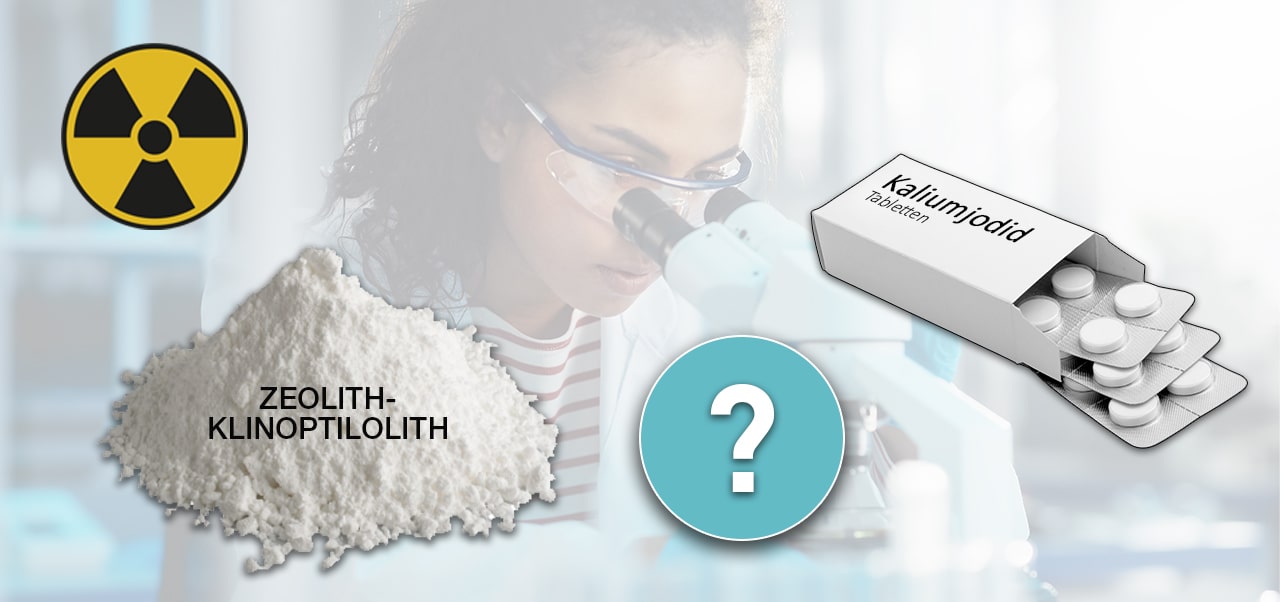Potassium Iodine Tablets - Zeolite Clinoptilolite A Useful Supplement Or Alternative?
PMA-Zeolite & science
Radioactivity, nuclear disaster, nuclear bombs - these are probably the most searched words on the Internet at the moment, which have gained massive interest due to the dramatic developments in Ukraine and express people's uncertainty and fear in the current situation. Artificial radioactivity is quite rightly seen as a threat to people and nature, as well as one's own health and above all the maintenance of health is more important than ever. Many questions are now being asked about the effect of zeolite clinoptilolite on radioactivity. It is now important to show what experiences have been made in nuclear disasters and what is the state of science. It's also important how zeolite clinoptilolite can offer itself as a useful supplement or unique alternative to potassium iodide iodine tablets.
Unlike natural radiation, which is usually very low, man-made radiation resulting from human activity can have much more devastating effects. After nuclear explosions, the most common radionuclides are cesium 137 and strontium 90. Cesium 137 is relatively quickly bound in the soil and then slowly absorbed by plants, accumulating mainly in their above-ground parts. Cesium accumulated in plants enters animal feed and concentrates, for example, in cow's milk and enters the human body through the food chain. Cesium 137, which enters the gastrointestinal tract, is practically 100% absorbed by the body. Strontium 90 is chemically similar to calcium and is therefore particularly easily absorbed by the body and incorporated into the bones.
The half-life of radioactive isotopes from the body, i.e. the period until half of the absorbed isotopes are excreted again, is estimated to be about 70 to 110 days for Cs137 and about 49 years for Sr90.
Use Of Zeolite Clinoptilolite In Nuclear Disasters In The Past
The first major documented use of zeolite clinoptilolite occurred in 1986 after the Chernobyl disaster in Ukraine. The consequences were comparable to the atomic bombings in Hiroshima and Nagasaki. The use of zeolite clinoptilolite in 1986 was as a therapeutic agent for radiation sick people and as a prophylactic for rescue workers. Similar results are reported from the Fukushima disaster.
Reports on the use of zeolite clinoptilolite after disasters such as Chernobyl, Hiroshima, Nagasaki, Fukushima are varied:
- Purification of contaminated water (purification degree about 98 - 99 %).
- Cleaning of contaminated soil.
- Prophylactic intake by rescue workers.
- Addition to the soil in greenhouses (80 - 70 % reduction of Cs137 and Sr90 in the plants).
- For decontamination of children, chocolate and cookies were prepared with 2 to 30% by weight of clinoptilolite.
- Admixture to food (increased decomposition of radionuclides by a factor of 3 - 5).
- Admixture to feed of farm animals resulted in 50 - 70 % reduction of contamination in meat and 80 - 85 % in milk). In Bulgaria, the addition of 10% clinoptilolite to cow feed reduced the cesium content of cow milk by 30%.
- Sheathing of the Chernobyl reactor with an estimated 22 000 t of zeolite.
Why Could Zeolite Clinoptilolite Help With Radioactivity?
Zeolite clinoptilolite has an outstanding binding effect on cesium 137 (about 95%) and strontium 90 (about 80%), both substances that come from man-made radioactivity and have a high potential to harm humans - from radiation burns to gene damage and cancer. Once bound, zeolite clinoptilolite does not release these isotopes and naturally carries them out of the body through the stool.
However, it is important to know that the effect only takes place in the gastrointestinal tract and therefore only isotopes that can be found there can be bound, but not those that have already accumulated in the body. Therefore, the use of zeolite-clinoptilolite should be done early and already as a preventive measure. Binding of isotopes, which are absorbed through food and drink, is possible to a high degree. However, this does not apply to isotopes that are absorbed through the lungs or skin.
Here it also immediately shows the difference to potassium iodide iodine tablets. These protect the thyroid gland against the uptake of radioactive iodine and thus against radiation-induced thyroid cancer. However, they do not provide protection against the absorption of other radionuclides into the body.
In the therapy of radiation-damaged patients, it was clearly shown that the use of zeolite clinoptilolite should take place within the first 10 days. After that, it was very difficult to therapeutically control the progressive pathological process of radiation disease. This observation is consistent with the mechanism of action, according to which isotopes located in the organism outside the gastrointestinal tract can no longer be bound.
One-time radiation damage was easier to treat. Greater difficulties arose in the case of repeated ingestion via food and water. Since it was not known specifically which foods were contaminated and which were not, a continuous intake of zeolite clinoptilolite was recommended for the entire period of potential exposure.
Radiation patients were treated for at least 36 days. The dosage was in the range of 3 to 8 g of zeolite per day, generally in powder form stirred into a glass of water and administered once a day. Minerals, vitamins and amino acids were administered throughout the day. According to recent findings, spreading the intake of zeolite clinoptilolite over two to three servings per day is equally promising. Interaction with minerals, vitamins and trace elements is not expected, therefore simultaneous intake with (contaminated) food can be done.
The results clearly show that the use of zeolite clinoptilolite is able to reduce, though not completely eliminate, exposure - mainly because radioactivity that enters the body through the skin and lungs cannot be bound.
Since the use of zeolite has been predominantly in disasters, and ethical considerations generally preclude the conduct of double-blind studies, there are mainly reports from practical applications. In disaster situations, lengthy studies cannot be conducted in a standardized manner, nor can they be planned. This report provides a brief overview of the subject, without claiming to be complete and reduced to the most essential points.
In the event of nuclear disasters, the following general recommendations can be derived:
- Stay home.
- Keep windows closed.
- Listen to the radio for information on current developments.
- Wear an FFP2 mask outdoors to reduce potential ingestion of radioactive dust.
- Wear clothing outdoors only once or wash yourself and your clothing thoroughly once you return home.
- Purify your drinking water if possible.
- Wash your food thoroughly before preparing it.
- Potassium iodide tablets to protect the thyroid gland from radioactive iodine should not be taken carelessly. Generally, it is considered advisable for children to take them; adults should take them only when medically necessary. In any case, check with your doctor or pharmacist before taking them.
- For the period of potential exposure to radiation, the authors of scientific documents recommend continuous intake of zeolite clinoptilolite throughout the day.
- Be sure to use tested and approved products from established manufacturers.
In summary, based on the existing data and findings from disaster use with zeolite clinoptilolite in the course of nuclear incidents, there is a potential for reducing nuclear radiation damage to the human organism, but also in livestock and other areas. Moreover, in the case of approved and appropriately tested zeolite products for human use, the probability of occurrence of side effects and unexpected side effects is low, and a possible benefit is by far predominant. The recommendation of the scientific authors on the subject is an early start of continuous use of zeolite clinoptilolite over the period of potential risk.
Sources:
- FACT SHEET MAY 2014 Nuclear Forum Switzerland.
- https://www.lanuv.nrw.de/umwelt/strahlung/radioaktivitaet/radiologische-grundlagen/natuerliche-und-kuenstliche-radioaktivitaet
- Pichl, 2006
- Armbruster, 2001
- Pavelic et al. 2017
- Lamprecht et al. 2015


